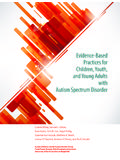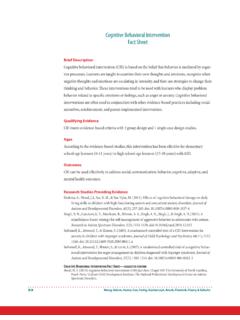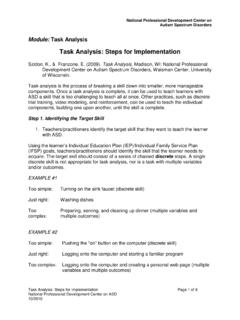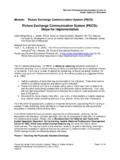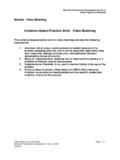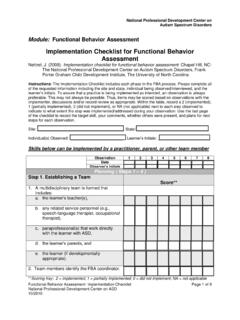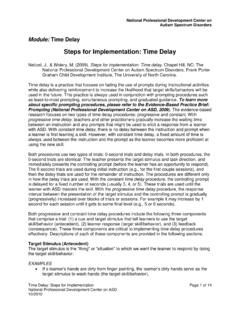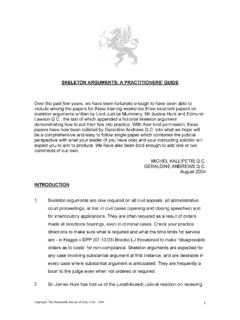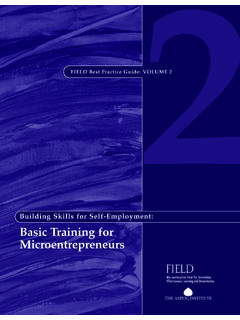Transcription of Steps for Implementation: Discrete Trial Training
1 National Professional Development Center on Autism Spectrum Disorders Module: Discrete Trial Training (DTT). step -BY- step INSTRUCTIONS. Steps for implementation : Discrete Trial Training Bogin, J., Sullivan, L., Rogers, S., & Stabel. A. (2010). Steps for implementation : Discrete Trial Training . Sacramento, CA: The National Professional Development Center on Autism Spectrum Disorders, The Institute, The University of California at Davis School of Medicine. Discrete Trial Training (DTT) is a method of teaching in which the adult uses adult- directed, massed Trial instruction, reinforcers chosen for their strength, and clear contingencies and repetition to teach new skills.
2 DTT is a particularly strong method for developing a new response to a stimulus. Its limitations involve lack of reinforcement of learner spontaneity and difficulty with generalization. Thus, once a skill is learned in the DTT format, it is important to develop plans for teaching generalized use of the new skill across environments, materials, and people, and also to develop teaching plans for learner initiation of the new skill. Using DTT for a learner with autism involves the following Steps . step 1. Deciding What to Teach: Assessment and Summarizing Results 1. Teachers/practitioners decide which of the learner s IFSP or IEP objectives will be taught using a DTT approach.
3 Some learning objectives are better taught using DTT than others. Objectives that involve fine and gross motor skills, recreation, self care, cognitive, and academic skills are very often appropriate for DTT. 2. Teachers/practitioners discuss the planned use of DTT for the particular learning objective with other team members, especially parents/family members. Team members who either have expertise in areas related to the objective or who will be teaching the skill should be consulted. This discussion could occur during the IEP/IFSP planning or progress review meeting. 3. Teachers/practitioners examine the target IEP/IFSP objective and refine if needed.
4 Since the DTT format relies on Discrete behaviors which have a clear beginning, middle, and end, the learning objective needs to clearly state the desired antecedent, behavior, and criterion for mastery. For example, a language objective for a learner with ASD is to give two objects to an adult. To address this objective using DTT, teachers/practitioners would need to refine it so that the antecedent, behavior, and criterion for mastery are identified in the following ways. Discrete Trial Training : Steps for implementation Page 1 of 9. National Professional Development Center on ASD. 10/2010. National Professional Development Center on Autism Spectrum Disorders Module: Discrete Trial Training (DTT).
5 Antecedent: Adult says to the learner, Give me two _____.. Behavior: Learner gives two objects to the adult. Criterion: Learner gives two objects to the adult during 80% of the trials. This refined objective would then read: When an adult asks Michael, to give two objects (antecedent phrase), Michael will pick up two objects and hand them to the adult (behavior phrase) in 80% of opportunities across three consecutive days (criterion). step 2. Breaking the Skill Down into Teachable Steps 1. Teachers/practitioners complete a task analysis of the skill, identify each step of the skill, and liststeps in sequential order from entry to mastery level.
6 The cornerstone of DTT is the use of task analysis to break down skills into small teachable Steps (Cohen, Amerine-Dickens, & Smith, 2006; Eikeseth, Smith, Jahr, &. Eldevik, 2002). To complete a task analysis, each step of the skill is broken down and listed in sequential order. For example, a task analysis for an objective involving naming pictures in a book might look like this: Target objective for a 4 year old: When looking at a book with an adult, Steffie will answer the adult s question What s that? , accompanied by a point to a picture, by naming 10 or more different pictures of animals and vehicles in five different unfamiliar books, during 90% of opportunities across three consecutive teaching sessions.
7 Mastery for each step is set at 90% correct independent response during three consecutive teaching periods. Steps /Lesson Progression 1. Names 2-3 animal pictures with partial verbal prompt 2. Names 2-3 animal pictures independently 3. Expressively identify 2-3 animal pictures in one familiar book 4. Expressively identify 4-5 animal pictures on cards 5. Names 4-5 animal pictures in five different books 6. Names 2-3 vehicle pictures with partial verbal prompt 7. Names 2-3 vehicle pictures independently 8. Names 2-3 vehicle pictures in one familiar book 9. Names 4-5 vehicle pictures on cards 10. Names 4-5 vehicle pictures in five different books For more information on how to complete a task analysis, please refer to the Evidence-Based Practice Brief: Task Analysis (National Professional Development Center on ASD, 2009).
8 Discrete Trial Training : Steps for implementation Page 2 of 9. National Professional Development Center on ASD. 10/2010. National Professional Development Center on Autism Spectrum Disorders Module: Discrete Trial Training (DTT). 2. After completing a task analysis for each skill, teachers/practitioners list the Steps clearly so any team member can complete the trials if necessary. When listing the Steps , the directions from the instructor (also called the stimulus or antecedent), the range of responses that are or are not acceptable, the prompting that may be required, and the consequence that the instructor must present to reinforce the desired behavior or to discourage an undesired behavior must be included.
9 Reviewing other evaluations/assessments may be useful to provide information about current levels of proficiency and where your teaching Steps might start. Evaluations that could be referenced include: speech/language, reading/literacy, and gross/fine motor. Reviewing a curriculum tool may be helpful if additional assistance is needed to decide on the Steps . Curriculum assessments can be helpful as guides for refining objectives, creating a hierarchy of skills, determining a baseline level of a skill, deciding on an age appropriate demonstration of the skill, and making decisions about what skills to teach and when to teach them.
10 Examples of curriculum-based assessment guides include: Teaching Developmentally Disabled Learners: The Me Book (Lovaas, 1981). Teaching Individuals with Developmental Delays (Lovaas, 2003). A Work in Progress (Leaf & McEachin, 1999). Behavioral Intervention for Young Learners with Autism (Maurice, Green, &. Luce, 1996). Assessment of Basic Learning and Language Skills (Partington & Sundberg, 1998). step 3. Setting-up the Data Collection System 1. Teachers/practitioners select data sheets specifically designed for the skill being taught. One of the defining characteristics of a high quality Discrete Trial Training program is the collection of Trial by Trial data.

